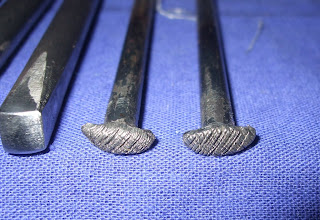At Pennsic this year there will be a St. Sebastian archery shoot. There will be a total of 8 winners in their classes. The theme is creatures from the Book of Kells. Scroll size will be 1/2 sheet of Pergamenta. The scrolls needed will be for the best shooter in: Archer.
---------------------------------------------------
“Born of ash and yew, strength in the hand and aim that is true,
A bow across the sky, another in the river,
Whence swallows upward fly, like arrows from a quiver”
Let all know that you have received the Accolade of Archer at the second annual Saint Sebastian Archery Competition at Pennsic 41 XLI.
---------------------------------------------------
Paper Stock: Pergamenata Heavyweight, 5X7 inches, from John Neal Bookseller
Paint: Gouache
Technique: Free hand sketched with a mechanical pencil.
Inked in with India ink applied with a metal-nibbed dip pen.
Applied color using brushed on gouache paint.
Inspiration: Various images from the Book of the Kells
This was my first scroll using Pergamenata. I love the stuff now. Even with the additional cost of the material I found it worth while for two major reasons. One: It looks a lot more like vellum than Bristol board. Two: Corrections are 20x easier on the stuff. I spelled Whence wrong on the scroll and was planning on starting over again as I would have done on Bristol board. I know you can "fix" Bristol, but it always look crummy when it is done. I figured I'd practice fixing it on this new stuff and found that scratching away the error was rather easy. Love the stuff.
After the all but he first letter of "Wence" was removed.
After the correction. I think in the future I'll have to wait a little longer and probably not scratch so hard. It pulled some fibers up from the paper and that lead to bleeding a bit, but all in all I like corrections on this more than other materials.
Crappy camera, but here are some close ups. This dragon is something I just made up to look like it came from the Book of the Kells, but fit the space left at the bottom. Also, adding a dragon to any scroll in the Midrealm is not a bad idea.
The above image was taken from my camera and the below image was my scanner. The scanner takes much brighter images, but I find that it also doesn't look as much like the original. The colors are almost artificially bright on the scanned copy. Nothing beats seeing artwork in person I guess.



























































